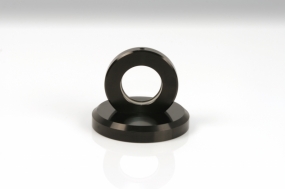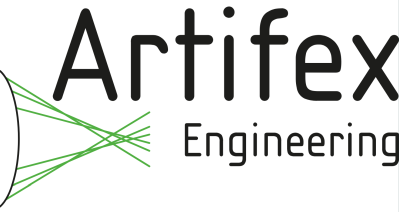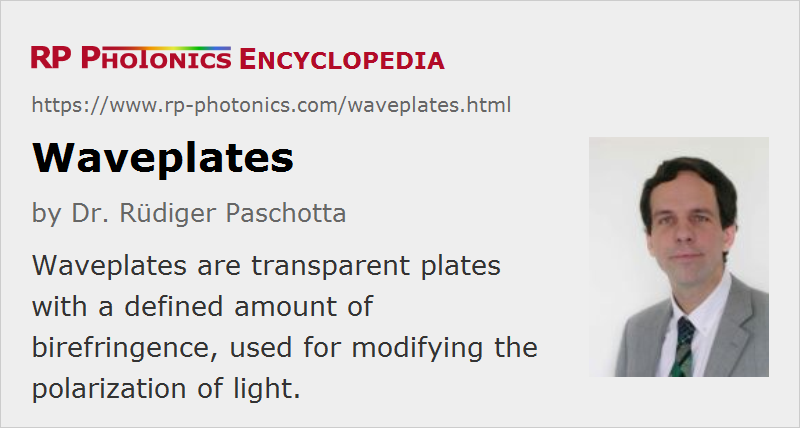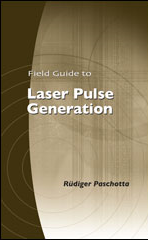Waveplates
Definition: transparent plates with a defined amount of birefringence, used for modifying the polarization of light
Alternative terms: retarder plates, retarders
German: Wellenplatten
Categories: general optics, photonic devices
How to cite the article; suggest additional literature
Author: Dr. Rüdiger Paschotta
Optical waveplates (also called wave plates or retarder plates) are transparent plates with a carefully chosen amount of birefringence. They are mostly used for manipulating the polarization state of light beams. A waveplate has a slow axis and a fast axis, both being perpendicular to the beam direction, and also to each other. The phase velocity of light is slightly higher for polarization along the fast axis. The designed value of optical retardance (difference in phase delay for the two polarization directions) is achieved only in a limited wavelength range (see below) and in a limited range of incidence angles.
Common Types and Applications
The most common types of waveplates are quarter-wave plates (λ/4 plates) and half-wave plates (λ/2 plates), where the difference of phase delays between the two linear polarization directions is π/2 or π, respectively, corresponding to propagation phase shifts over a distance of λ / 4 or λ / 2, respectively.
Some important cases are:
- When a light beam is linearly polarized, and the polarization direction is along one of the axes of the waveplate, the polarization remains unchanged.
- When the incident polarization does not coincide with one of the axes, and the plate is a half-wave plate, then the polarization stays linear, but the polarization direction is rotated. For example, for an angle of 45° to the axes, the polarization direction is rotated by 90°.
- When the incident polarization is at an angle of 45° to the axes, a quarter-wave plate generates a state of circular polarization. (Other input polarizations lead to elliptical polarization states.) Conversely, circularly polarized light is converted into linearly polarized light.
Within a laser resonator, two quarter-wave plates around the gain medium are sometimes used for obtaining single-frequency operation (→ twisted-mode technique). Inserting a half-wave plate between a laser crystal and a resonator end mirror can help to reduce depolarization loss. The combination of a half-wave plate and a polarizer allows one to realize an output coupler with adjustable transmission.
Many waveplates are made of crystalline quartz (SiO2), as this optical material exhibits a wide wavelength range with very high transparency, and can be prepared with high optical quality. Other possible materials (to be used e.g. in other wavelength regions) are calcite (CaCO3), magnesium fluoride (MgF2), sapphire (Al2O3), mica (a silicate material), and some birefringent polymers.
Zero-order and Multiple-order Plates
There are different kinds of waveplates:
- True zero-order waveplates are so thin that the relative optical phase delay between the two polarization directions is just π, for example, for a half-wave plate. While this is the ideal case, the thickness of true zero-order plates can be inconveniently small, particularly for strongly birefringent materials such as calcite, so that the optical fabrication becomes difficult and the handling delicate. The latter problem can be eliminated by cementing (or bonding) a zero-order plate to a thicker glass plate, which is not birefringent but provides mechanical stabilization. The resulting interface, however, leads to a lower damage threshold such as 10 MW/cm2.
- Multiple-order waveplates (= multi-order plates) are made so that the relative phase change is larger than the required value by an integer multiple of 2π. Although the performance at the design wavelength can be essentially the same, the optical bandwidth in which the plate has roughly the correct relative phase change is limited. Also, the retardance has a higher temperature sensitivity.
- Low-order waveplates are multiple-order plates with a relatively small order, keeping the mentioned detrimental effects low.
- Effective zero-order waveplates (or net zero-order waveplates) can be made from two multiple-order plates with slightly different thicknesses, which are cemented or optically contacted, or air-spaced for application with higher optical power levels. The slow axis of one plate is aligned with the fast axis of the other plate, so that the birefringence of the two plates is nearly canceled. The difference in thickness must be adjusted to obtain the required net phase change. Such devices can work in a broad wavelength range, since wavelength-induced changes of retardance in one plate are compensated by the other plate.
It is also possible to make achromatic waveplates, combining materials with different chromatic dispersion (e.g. quartz and MgF2), which can have a nearly constant retardance over a very wide spectral range (hundreds of nanometers). Also, there are dual-wavelength waveplates, which have well-defined retardance values at some discrete very different wavelengths. Such features are sometimes required in the context of nonlinear frequency conversion, such as frequency tripling.
Various Issues
In addition to the fundamental optical performance, various other issues can be relevant:
- The materials should have a high transparency in the wavelength region of interest.
- The sensitivity of the phase retardance to temperature and angle depends on the design.
- High-quality waveplates exhibit a uniform retardance over the full open aperture, or a large portion of it.
- Surface reflections can be disturbing, and may be reduced with anti-reflection coatings.
- The optical damage threshold can be important for applications in pulsed laser systems.
- Some waveplates are provided with a housing which makes it easy to rotate the plate by a well-defined angle, and/or to see the orientation of the fast and slow axis.
For some applications, it can be difficult to obtain a waveplate fulfilling all the requirements. Therefore, one sometimes has to use alternative methods, for example for turning the polarization direction of a laser beam. For example, a 90° rotation of polarization (and also the beam profile) can be obtained with a combination of three 45° mirrors, subsequently deflecting the beam to the right, then upwards and finally into the original direction.
Related Devices
There are optical devices which are somewhat related to waveplates:
- Fresnel rhomb retarders and other types of prism retarders have the same basic function as waveplates, but exploit polarization-dependent phase changes during total internal reflection. This principle allows broadband (achromatic) operation.
- A Babinet–Soleil compensator, containing a pair of birefringent wedges, can be used as a waveplate with a variable degree of retardation. Other versions of tunable waveplates such as the Berek compensator are based on variable tilting of birefringent plates.
- There are various types of fiber polarization controllers with similar functions.
- Electro-optic crystals and liquid crystal devices can be used to make electrically controllable waveplates, also called active retarders.
Suppliers
The RP Photonics Buyer's Guide contains 76 suppliers for waveplates. Among them:


Knight Optical
Known for their outstanding reliability and high quality, Knight Optical's retarders are used for the most cutting-edge applications. With options suitable for the UV, visible and near-infrared (NIR) (0.7 to 1.5 μm) wavebands, our range consists of liquid crystal variable (custom-made only), achromatic, mica, zero order quartz, low order quartz, Fresnel rhomb (custom-made only), plastic and Rochon (custom-made only) varieties.


Edmund Optics
Edmund Optics offers a variety of waveplates with crystalline or polymer materials, including multiple order, zero order, or achromatic waveplates. Polymer waveplates offer superior performance over a wider range of incidence angles. Multiple order waveplates are ideal for use with monochromatic light that deviates less than 1% of the waveplate’s design wavelength. Zero order retarders offer high performance over wider wavelength or temperature ranges. Achromatic waveplates offer the most constant performance over the widest wavelength or temperature ranges.

EKSMA OPTICS
We offer a wide choice of zero-order, multiple-order and low-order waveplates made from crystalline quartz. Dual-wavelength waveplates for Ti:sapphire, Yb:KGW/KYW and Nd:YAG lasers. Achromatic waveplates for operation with tunable lasers.


G&H
From crystal growth, crystal orientation and cutting, to waveplate fabrication and coating, no other waveplate supplier has as much control over the fabrication stages as G&H.
Our waveplates been used in the cutting edge of research at Lawrence Livermore National Laboratory’s NIF project to the most demanding of production environments in semiconductor metrology equipment.
For all wavelength ranges, we orient, cut, and polish the optical crystals for waveplate production. Tight internal controls enable better retardation tolerances within and between production runs.
Polishing, coating, assembly, and metrology complete the manufacturing process.

Shanghai Optics
Shanghai Optics manufacturers micro-waveplates as small as 0.35 mm × 0.35 mm with tolerance of ±0.05 mm and thickness about 0.19 mm. Please contact us for manufacturing limit or custom specifications.


Artifex Engineering
Artifex Engineering offers a wide range of custom waveplates for many applications. Waveplates, also known as retardation plates, are birefringent optical elements. Our portfolio covers achromatic, low order, zero and true zero order and MID-IR waveplates. Mounts are available for our waveplates on request. For example, we can provide true zero order plates mounted on an annular glass frame. In this manner, a robust optic is available with the full optical properties of a true zero order waveplate. In addition to single components, we will gladly provide functional subunits according to your needs. For example, we can supply isolators comprising a quarter-waveplate and polarizing beamsplitter cube mounted together in a single drop-in unit. Visit our product page for more information on each waveplate. We look forward to your inquiry.
Questions and Comments from Users
Here you can submit questions and comments. As far as they get accepted by the author, they will appear above this paragraph together with the author’s answer. The author will decide on acceptance based on certain criteria. Essentially, the issue must be of sufficiently broad interest.
Please do not enter personal data here; we would otherwise delete it soon. (See also our privacy declaration.) If you wish to receive personal feedback or consultancy from the author, please contact him e.g. via e-mail.
By submitting the information, you give your consent to the potential publication of your inputs on our website according to our rules. (If you later retract your consent, we will delete those inputs.) As your inputs are first reviewed by the author, they may be published with some delay.
See also: polarization of light, retardance, twisted-mode technique, fiber polarization controllers, Babinet–Soleil compensators
and other articles in the categories general optics, photonic devices
 |






If you like this page, please share the link with your friends and colleagues, e.g. via social media:
These sharing buttons are implemented in a privacy-friendly way!